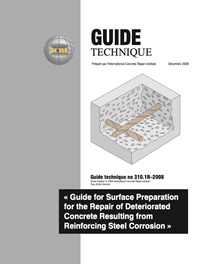
- License:
- Short Description:
- Este lineamiento proporciona una guía sobre la remoción de concreto y los procedimientos para la preparación de la superficie paray la reparación del de concreto deteriorado provocado por la corrosión del acero de refuerzo. Se discuten la geometría de la remoción, la configuración del área de reparación, el proceso de remoción, la preparación del borde, la reparación del refuerzo, la preparación e inspección de la superficie necesarias para las reparaciones durables. Se incluyen consideraciones especiales para la remoción de concreto asociada con la reparación de columnas.
- Price:
- $0.00 - $38.00
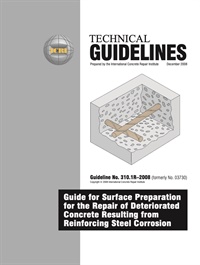
- License:
- Short Description:
- Outlines the steps in preparing concrete for replacement material in areas where corroded reinforcing steel has caused cracking, spalling, delamination, or other types of deterioration. Topics covered include exposing and undercutting reinforcing steel, edge and surface conditioning, repair of reinforcing steel, and removal geometry.
- Price:
- $0.00 - $38.00
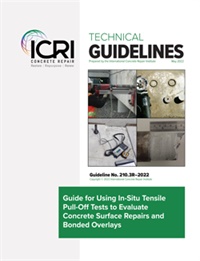
- License:
- Short Description:
- This guide provides a recommended method of evaluating the adequacy of concrete surface preparation and tensile bond strength of cementitious and polymer concrete surface repairs using the in-situ drilled core tensile pulloff test. The guide outlines equipment and material requirements, the test procedure, reporting, and acceptance criteria. This update also includes failure modes for concrete substrate tests.
- Price:
- $0.00 - $62.00
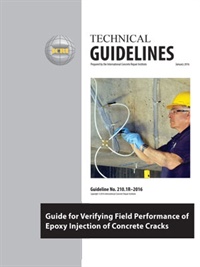
- License:
- Short Description:
- This guideline is intended to assist the contractor, licensed design professional, and owner in the development of performance specifications for quality assurance and quality control of epoxy injection of concrete cracks. It includes process-control methods to assess if satisfactory injection work is being performed. Quality assurance methods described include visual observations and testing samples during the injection work, and removing concrete core samples and performing nondestructive testing of completed repairs.
- Price:
- $0.00 - $62.00

- License:
- Short Description:
- This guideline is intended to provide information on electrochemical techniques used to mitigate the corrosion of steel in atmospherically exposed concrete structures. The information presented is based on testing and the experience of owners, engineers, contractors, and suppliers. This guideline includes information on impressed current and galvanic cathodic protection, electrochemical chloride extraction, and realkalization.
- Price:
- $0.00 - $62.00
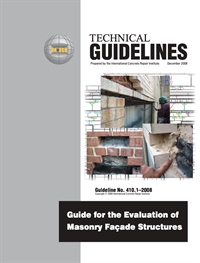
- License:
- Short Description:
- This guideline describes the tools, techniques, and processes that are used in the evaluation of masonry façade structures. It offers background into the history and evolution of masonry structure design and construction.
- Price:
- $0.00 - $62.00
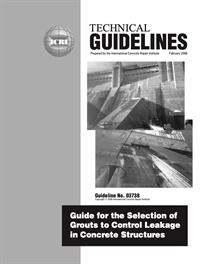
- License:
- Short Description:
- This guideline provides information on the properties and characteristics of grout materials for selection of a proper grout material to control water leakage through cracks and other discontinuities in concrete structures. It is also for the selection of grout materials for crack injection to control leaks through cracks in concrete structures. (formerly no. 03738).
- Price:
- $0.00 - $62.00
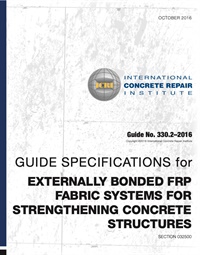
- License:
- Short Description:
- This is the second document in a series of guide specifications prepared by ICRI. The guide specification addresses the requirements for the supply and installation of FRP fabric systems by providing specification text, optional requirements, references, and commentary to allow the user to tailor the document to a specific structural strengthening repair project, and use as a technical specification section in a complete project manual. Both the printed and PDF copies include a Word document with hidden text for easy modification of text to meet specific repair project requirements. Note that the design of the FRP system is outside the scope of these guide specifications.
- Price:
- $0.00 - $80.00
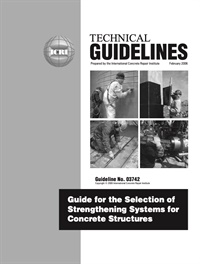
- License:
- Short Description:
- An aid for the selection process, this guideline describes several methods of strengthening structures including externally bonded systems, post-tensioning, section enlargement and supplemental supports (formerly no. 03742).
- Price:
- $0.00 - $62.00
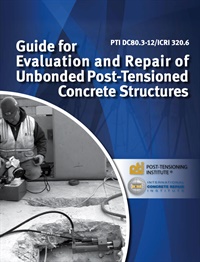
- License:
- Short Description:
- This guide is intended to provide an introduction to the techniques and procedures used to evaluate and repair existing concrete structures post-tensioned with unbonded single-strand tendons. This guide demonstrates how the strength and serviceability of a structure that has experienced deterioration can be evaluated and restored to its original—or greater—strength and serviceability. Post-tensioning design, evaluation, and repair requires specialized knowledge. There is no substitute for experience and knowledge in working with post-tensioned structures. An experienced contractor and licensed design professional team is essential when working with post-tensioned structures. [Replaces 210.2–2002 (Evaluation) AND 320.4–2006 (Repair)]
- Price:
- $50.00 - $100.00
Please wait ...